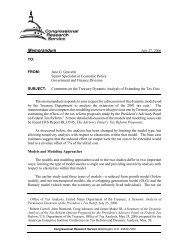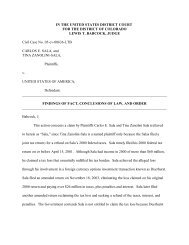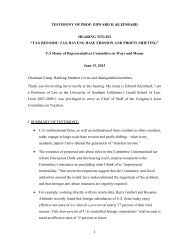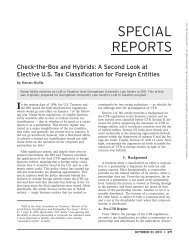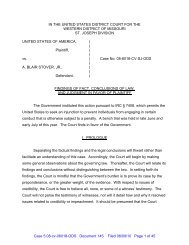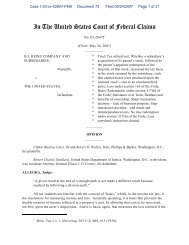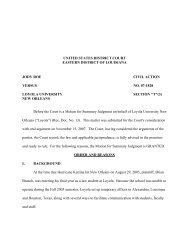Targeted Allocations Hit the Spot
Targeted Allocations Hit the Spot
Targeted Allocations Hit the Spot
Create successful ePaper yourself
Turn your PDF publications into a flip-book with our unique Google optimized e-Paper software.
COMMENTARY / SPECIAL REPORT<br />
Under that approach, <strong>the</strong> extraordinary adjustments<br />
(gross income allocation or guaranteed payment)<br />
would be made only if <strong>the</strong> partners’ robust<br />
expectations did not materialize and <strong>the</strong> shortfall<br />
remaining at <strong>the</strong> end of <strong>the</strong> life of <strong>the</strong> partnership<br />
was made up of liquidating proceeds. 40 This avoids<br />
extraordinary year-to-year phantom income adjustments.<br />
This result would appear to be consistent with<br />
<strong>the</strong> partner’s interest in <strong>the</strong> partnership. The normal<br />
tax snapshot — tax basis equals value — does not<br />
reflect economic reality. It seems inconsistent with<br />
<strong>the</strong> partner’s interest in <strong>the</strong> partnership test to<br />
require a gross income allocation or a guaranteed<br />
payment or a taxable capital shift for an earnings<br />
shortfall in a particular year when <strong>the</strong> value of <strong>the</strong><br />
property may have increased dramatically and <strong>the</strong><br />
future looks robust.<br />
F. Potential Drafting Issues<br />
The drafting treatise 41 offers <strong>the</strong> following checklist<br />
of drafting issues with targeted allocations:<br />
1. Circularity: Drafters sometimes forget to<br />
remove ‘‘liquidation in accordance with capital<br />
accounts’’ from <strong>the</strong> distribution provisions.<br />
Leaving it in produces a circular definition.<br />
2. Distribution provisions: The targeted allocation<br />
provision puts more pressure on drafting<br />
accurate distribution provisions. Also, it<br />
may be more difficult to allocate tiers of losses<br />
to partners. This may need to be accomplished<br />
by specifying <strong>the</strong> amount <strong>the</strong> partner is entitled<br />
to receive if liquidation occurs at various<br />
times, which may be tricky.<br />
3. Special allocations: The partnership agreement<br />
still needs to provide for special allocations<br />
relating to nonrecourse deductions,<br />
qualified income offset, etc., and profits and<br />
losses based on book income. The drafting<br />
treatise adds that <strong>the</strong> curative allocation provision<br />
is not needed because targeted allocations<br />
are inherently curative.<br />
4. Priority returns: As with traditional allocation<br />
provisions, <strong>the</strong> drafter of a targeted allocation<br />
provision still needs to deal with<br />
whe<strong>the</strong>r priority returns of capital should be<br />
matched (if at all) with profits or items of gross<br />
income. If <strong>the</strong>y are not so matched, <strong>the</strong> partner<br />
receives back his capital tax free. If <strong>the</strong>y are so<br />
matched, <strong>the</strong> partner is simply receiving a<br />
priority income allocation ra<strong>the</strong>r than a priority<br />
return of capital.<br />
5. Disproportionate losses: The drafting treatise<br />
says <strong>the</strong> targeted allocation is difficult to<br />
use if <strong>the</strong> business deal calls for a disproportionate<br />
allocation of depreciation or losses and<br />
a chargeback only out of gains, not profits.<br />
The drafting treatise is somewhat dismissive of<br />
targeted allocations, apparently based on <strong>the</strong> view<br />
that <strong>the</strong> traditional capital account liquidation provision<br />
produces <strong>the</strong> right economic result for <strong>the</strong><br />
partners. 42 That’s <strong>the</strong>oretically true.<br />
Theory and practice can be very different, however,<br />
as <strong>the</strong> drafting treatise admits in <strong>the</strong> next<br />
paragraph on that same page:<br />
In all but <strong>the</strong> simplest transactions, this need<br />
to anticipate and accurately deal with a wide<br />
range of unpredictable future events imposes a<br />
tremendous burden on <strong>the</strong> drafter and creates a<br />
very real risk that some future events will be<br />
overlooked or mishandled. [Emphasis added.]<br />
With such a high risk of mistake, one wonders<br />
why <strong>the</strong> drafting treatise does not more readily<br />
embrace targeted allocations. Might it be better to<br />
err on <strong>the</strong> side of tax mistake ra<strong>the</strong>r than economic<br />
mistake and use targeted allocations<br />
V. Tracking <strong>Allocations</strong><br />
The targeted allocation provisions discussed in<br />
<strong>the</strong> preceding section secure <strong>the</strong> partner’s cash<br />
economics but provide relatively little guidance for<br />
<strong>the</strong> tax return preparer. <strong>Targeted</strong> allocation provisions<br />
also force tax practitioners to give up <strong>the</strong><br />
hard-learned craft of drafting complex tax allocation<br />
provisions. The somewhat terse ‘‘allocate tax<br />
items to give <strong>the</strong> right capital account’’ is much less<br />
elegant than a well-drafted tax allocation provision.<br />
For <strong>the</strong>se reasons, some drafters simply eschew<br />
reliance on capital accounts at all and draft partnership<br />
agreements with tax allocations that simply<br />
‘‘track’’ <strong>the</strong> distribution provisions, that is, ‘‘tracking<br />
allocations.’’ 43<br />
The drafting process begins with <strong>the</strong> distribution<br />
provisions. Once <strong>the</strong> distribution provisions are set,<br />
<strong>the</strong> drafter develops tax allocation provisions to<br />
reflect <strong>the</strong> cash distribution priorities. This is <strong>the</strong><br />
same process used in drafting traditional ‘‘liquidate<br />
in accordance with capital account’’ provisions,<br />
(C) Tax Analysts 2010. All rights reserved. Tax Analysts does not claim copyright in any public domain or third party content.<br />
40 See Lewis R. Steinberg, ‘‘Fun and Games With Guaranteed<br />
Payments,’’ 57 Tax Law. 533, 567 (2004). See also Kean, supra note<br />
31, at 415-417.<br />
41 Drafting treatise, supra note 27, at paras. 7-161 et seq.<br />
42 Id. at paras. 7-160.<br />
43 The term ‘‘tracking allocations’’ captures <strong>the</strong> concept, although<br />
<strong>the</strong> term may already be claimed by those who issue<br />
interests in a partnership that track specific investments.<br />
106 TAX NOTES, October 4, 2010







